| Listing 1 - 10 of 19 | << page >> |
Sort by
|
Periodical
Abstract | Keywords | Export | Availability | Bookmark
 Loading...
Loading...Choose an application
- Reference Manager
- EndNote
- RefWorks (Direct export to RefWorks)
Book
ISBN: 3540447423 Year: 2007 Publisher: Berlin : Springer Berlin Heidelberg,
Abstract | Keywords | Export | Availability | Bookmark
 Loading...
Loading...Choose an application
- Reference Manager
- EndNote
- RefWorks (Direct export to RefWorks)
Volume II/28 is a supplemented and revised edition of the preceding volumes II/7, II/15, II/21, II/23 and II/25, containing up to date information on the geometric parameters (internuclear distances, bond angles, dihedral angles of internal rotation etc.) of free inorganic and organic polyatomic molecules. All experimental methods for the determination of quantitative structural data of free molecules have been considered: microwave, infrared, Raman, electronic and photoelectron spectroscopy as well as electron diffraction. The data obtained by these methods have been critically evaluated and compiled. They are presented separately for each molecule, together with a computer-drawn schematic figure of the structure and the original literature.
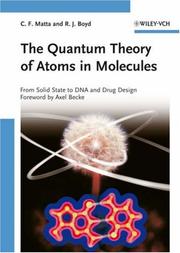
ISBN: 3527307486 9783527307487 Year: 2007 Publisher: New York: Wiley,
Abstract | Keywords | Export | Availability | Bookmark
 Loading...
Loading...Choose an application
- Reference Manager
- EndNote
- RefWorks (Direct export to RefWorks)
Quantum theory --- Molecular structure. --- Solid state physics. --- Quantum mechanics. Quantumfield theory --- Solid state physics --- Chemical structure --- Acqui 2006
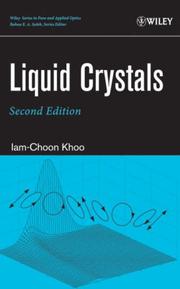
ISBN: 9780471751533 0471751537 Year: 2007 Publisher: Hoboken, N.J. : Wiley-Interscience,
Abstract | Keywords | Export | Availability | Bookmark
 Loading...
Loading...Choose an application
- Reference Manager
- EndNote
- RefWorks (Direct export to RefWorks)
Liquid crystals --- Cristaux liquides --- 539.22 --- Isotropy and anisotropy in molecular structure. Order-disorder. Texture of molecular systems and materials (especially synthetics) in general --- 539.22 Isotropy and anisotropy in molecular structure. Order-disorder. Texture of molecular systems and materials (especially synthetics) in general --- Crystals, Liquid --- Light sources

ISBN: 3540680136 3540680101 3642087620 Year: 2007 Publisher: Berlin, Heidelberg : Springer Berlin Heidelberg : Imprint: Springer,
Abstract | Keywords | Export | Availability | Bookmark
 Loading...
Loading...Choose an application
- Reference Manager
- EndNote
- RefWorks (Direct export to RefWorks)
Atomic Structure Theory is a textbook for students with a background in quantum mechanics. The text is designed to give hands-on experience with atomic structure calculations. Material covered includes angular momentum methods, the central field Schrödinger and Dirac equations, Hartree-Fock and Dirac-Hartree-Fock equations, multiplet structure, hyperfine structure, the isotope shift, dipole and multipole transitions, basic many-body perturbation theory, configuration interaction, and correlation corrections to matrix elements. Numerical methods for solving the Schrödinger and Dirac eigenvalue problems and the (Dirac)-Hartree-Fock equations are given as well. B-spline basis sets are used to carry out sums arising in higher-order many-body calculations. Illustrative problems are provided, together with solutions. FORTRAN programs implementing the numerical methods in the text are included.
Atomic structure --- Atomic structure. --- Structure, Atomic --- Atomic theory --- Mathematics. --- Quantum theory. --- Chemistry. --- Chemistry, Physical organic. --- Atomic, Molecular, Optical and Plasma Physics. --- Atomic/Molecular Structure and Spectra. --- Quantum Physics. --- Theoretical and Computational Chemistry. --- Physical Chemistry. --- Numerical and Computational Physics, Simulation. --- Chemistry, Physical organic --- Chemistry, Organic --- Chemistry, Physical and theoretical --- Physical sciences --- Quantum dynamics --- Quantum mechanics --- Quantum physics --- Physics --- Mechanics --- Thermodynamics --- Atoms. --- Physics. --- Atomic structure . --- Molecular structure . --- Quantum physics. --- Chemistry, Physical and theoretical. --- Physical chemistry. --- Chemistry, Theoretical --- Physical chemistry --- Theoretical chemistry --- Chemistry --- Structure, Molecular --- Chemical structure --- Structural bioinformatics --- Natural philosophy --- Philosophy, Natural --- Dynamics --- Matter --- Stereochemistry --- Constitution --- Molecular structure.
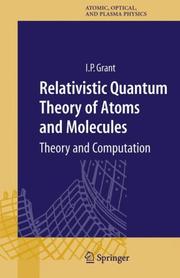
ISBN: 9781441922403 9780387346717 0387346716 1441922407 9786610852482 1280852488 0387350691 Year: 2007 Publisher: New York : Springer,
Abstract | Keywords | Export | Availability | Bookmark
 Loading...
Loading...Choose an application
- Reference Manager
- EndNote
- RefWorks (Direct export to RefWorks)
This book presents a unified approach to modern relativistic theory of the electronic structure of atoms and molecules which will provide experimental and theoretical scientists and graduate students with a range of powerful computational tools for a growing range of physical, chemical, technological and biochemical applications. Starting from its foundations in quantum electrodynamics, the book contains a careful account of relativistic atomic and molecular structure based on Dirac's relativistic Hamiltonian, and the numerical algorithms implemented by modern computer programs. The relativistic atomic structure code GRASP, which can compute atomic energy levels, radiative transition rates and other atomic properties using the multiconfigurational Dirac-Hartree-Fock or relativistic configuration interaction methods, is reviewed along with the relativistic R-matrix code DARC, which is used for the high precision modelling of the interactions of atoms and ions with photons and electrons. The recently developed BERTHA relativistic molecular structure code, the first to exploit fully the symmetry properties of Dirac 4-component spinors, provides a new resource for studying the properties of molecules, atomic clusters and other materials, especially those containing heavy elements for which a relativistic model is essential.
Relativistic quantum theory --- Atomic structure --- Molecular structure --- Théorie quantique relativiste --- Structure atomique --- Structure moléculaire --- Atomic structure. --- Molecular structure. --- Relativistic quantum theory. --- Chemistry --- Physical Sciences & Mathematics --- Physical & Theoretical Chemistry --- Atomic Physics --- Physics --- Théorie quantique relativiste --- Structure moléculaire --- EPUB-LIV-FT LIVPHYSI SPRINGER-B --- Structure, Molecular --- Structure, Atomic --- Relativistic quantum mechanics --- Physics. --- Physical chemistry. --- Gravitation. --- Quantum physics. --- Atoms. --- Spectra. --- Quantum Physics. --- Atomic, Molecular, Optical and Plasma Physics. --- Classical and Quantum Gravitation, Relativity Theory. --- Atomic/Molecular Structure and Spectra. --- Physical Chemistry. --- Chemical structure --- Structural bioinformatics --- Atomic theory --- Analysis, Spectrum --- Spectra --- Spectrochemical analysis --- Spectrochemistry --- Spectroscopy --- Chemistry, Analytic --- Interferometry --- Optics --- Radiation --- Wave-motion, Theory of --- Absorption spectra --- Light --- Spectroscope --- Chemistry, Physical and theoretical --- Matter --- Stereochemistry --- Quantum dynamics --- Quantum mechanics --- Quantum physics --- Mechanics --- Thermodynamics --- Field theory (Physics) --- Antigravity --- Centrifugal force --- Relativity (Physics) --- Chemistry, Theoretical --- Physical chemistry --- Theoretical chemistry --- Natural philosophy --- Philosophy, Natural --- Physical sciences --- Dynamics --- Qualitative --- Constitution --- Properties --- Quantum theory --- Special relativity (Physics) --- Quantum theory. --- Chemistry, Physical organic. --- Chemistry, Physical organic --- Chemistry, Organic --- Atomic structure . --- Molecular structure .
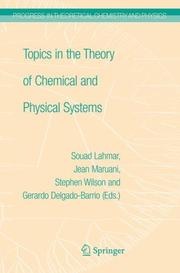
ISBN: 1280816457 9786610816453 1402054602 1402054599 9401781230 Year: 2007 Publisher: Dordrecht ; London : Springer,
Abstract | Keywords | Export | Availability | Bookmark
 Loading...
Loading...Choose an application
- Reference Manager
- EndNote
- RefWorks (Direct export to RefWorks)
Topics in the Theory of Chemical and Physical Systems is a collection of 14 selected papers from the scientific presentations made at the 10th European Workshop on Quantum Systems in Chemistry and Physics held at Carthage, Tunisia, in September 2005. This book encompasses a spectrum of topics in which emphasis is placed on theoretical methods in the study of chemical and physical properties of various systems: Advanced Methodologies Interactions and Clusters Excited States and Condensed Matter This volume is an invaluable resource for all academics and researchers interested in theoretical, quantum or computational chemistry, physical chemistry and chemical physics, particularly molecular structure and spectroscopy, interactions and complexes. It presents a selection of some of the most advanced methodologies, results and insights in these various areas.
Quantum chemistry --- Chemistry. --- Physical sciences --- Chemistry, Physical organic. --- Materials. --- Quantum theory. --- Theoretical and Computational Chemistry. --- Physical Chemistry. --- Materials Science, general. --- Quantum Physics. --- Atomic/Molecular Structure and Spectra. --- Atomic, Molecular, Optical and Plasma Physics. --- Quantum dynamics --- Quantum mechanics --- Quantum physics --- Physics --- Mechanics --- Thermodynamics --- Engineering --- Engineering materials --- Industrial materials --- Engineering design --- Manufacturing processes --- Chemistry, Physical organic --- Chemistry, Organic --- Chemistry, Physical and theoretical --- Materials --- Chemistry, Physical and theoretical. --- Physical chemistry. --- Materials science. --- Quantum physics. --- Atomic structure . --- Molecular structure . --- Atoms. --- Physics. --- Natural philosophy --- Philosophy, Natural --- Dynamics --- Matter --- Stereochemistry --- Structure, Molecular --- Chemical structure --- Structural bioinformatics --- Structure, Atomic --- Atomic theory --- Material science --- Chemistry, Theoretical --- Physical chemistry --- Theoretical chemistry --- Chemistry --- Constitution --- Physical systems
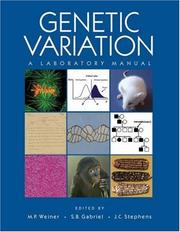
ISBN: 9780879697808 0879697806 9780879697792 0879697792 Year: 2007 Publisher: Cold Spring Harbor, N.Y.: Cold Spring Harbor Laboratory,
Abstract | Keywords | Export | Availability | Bookmark
 Loading...
Loading...Choose an application
- Reference Manager
- EndNote
- RefWorks (Direct export to RefWorks)
This compendium of protocols is specifically geared towards genetic variation studies, and includes thorough discussions on their applications for human and model organism studies. Intended for graduate students and professional scientists in clinical and research settings, it covers the complete spectrum of genetic variation, from SNPs and microsatellites to more complex DNA alterations, including copy number variation. The early sections of the manual are devoted to study design and generating genotype data, the use of resources such as HapMap and dbSNP, as well as experimental, statistical, and bioinformatic approaches for analyzing the data. The final sections include descriptions of genetic variation in model organisms and discussions of recent insights into human genetic ancestry, forensics, and human variation.
Molecular genetics --- Variation (Biology) --- Génétique moléculaire --- Variation (Biologie) --- Handbooks, manuals, etc --- Guides, manuels, etc. --- Genetic Variation --- Molecular Biology --- methods --- Génétique moléculaire --- 575.3 --- 575.3 Molecular genetics --- Molecular structure. --- Genetic Techniques. --- Molecular genetics - Laboratory manuals --- Variation (Biology) - Laboratory manuals --- Genetic Variation - laboratory manuals --- Molecular Biology - methods - laboratory manuals --- Genetic Techniques --- Variation (genetics)
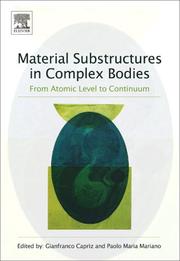
ISBN: 1281076716 9786611076719 0080554717 0080445357 9780080445359 9780080554716 9781281076717 6611076719 Year: 2007 Publisher: London : Elsevier,
Abstract | Keywords | Export | Availability | Bookmark
 Loading...
Loading...Choose an application
- Reference Manager
- EndNote
- RefWorks (Direct export to RefWorks)
Stringent industrial requirements of sophisticated performances and of circumstantial control for micro-devices or nanotechnology manufactures, and other types of machinery at multiple scales, can be satisfied often only by resort to or allowance for complex materials. The adjective 'complex' beckons to the fact that the substructure influences gross mechanical behaviour in a prominent way and interactions due to substructural changes are represented directly. The description of the mechanical behaviour of complex bodies proposes a wide class of challenging problems from macroscopic-to-nano-wo
Microstructure. --- Materials science. --- Atomic structure. --- Molecular structure. --- Nanostructured materials. --- Nanomaterials --- Nanometer materials --- Nanophase materials --- Nanostructure controlled materials --- Nanostructure materials --- Ultra-fine microstructure materials --- Microstructure --- Nanotechnology --- Structure, Molecular --- Chemical structure --- Structural bioinformatics --- Structure, Atomic --- Atomic theory --- Material science --- Physical sciences --- Materials --- Matter --- Morphology --- Micromechanics --- Stereology --- Constitution
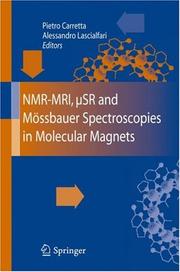
ISBN: 1281140759 9786611140755 8847005329 8847005310 Year: 2007 Publisher: Milano : Springer,
Abstract | Keywords | Export | Availability | Bookmark
 Loading...
Loading...Choose an application
- Reference Manager
- EndNote
- RefWorks (Direct export to RefWorks)
The discovery of molecular nanomagnets showing novel quantum effects, as the quantum tunneling of the magnetization, has brought to a renewed interest for the study of molecular magnetism and multifunctional molecular material. These materials have recently triggered an intense research activity in view of their possible applicabilities as, for example, as nanosized information storage units and as magnetic nanoparticles for bio-medicine. Several fundamental aspects of the microscopic static and dynamic properties of these molecular materials have been obtained by means of spectroscopies using local probes, as nuclei and muons. In this book an extensive overview on the results obtained during the last decade and on recent achievements in the study of molecular magnets by means of Nuclear Magnetic Resonance, Muon Spin Rotation, Magnetic Resonance Imaging and Mossbauer techniques is presented. The aim is to introduce the reader to these techniques and to give a general background on their application to molecular spin systems.
Nuclear magnetic resonance. --- Mössbauer spectroscopy. --- Spectroscopy, Mössbauer --- Spectrum analysis --- Mössbauer effect --- Magnetic resonance, Nuclear --- NMR (Nuclear magnetic resonance) --- Nuclear spin resonance --- Resonance, Nuclear spin --- Magnetic resonance --- Nuclear spin --- Nuclear quadrupole resonance --- Magnetism. --- Atomic/Molecular Structure and Spectra. --- Solid State Physics. --- Spectroscopy and Microscopy. --- Magnetism, Magnetic Materials. --- Biological and Medical Physics, Biophysics. --- Mathematical physics --- Physics --- Electricity --- Magnetics --- Atomic structure . --- Molecular structure . --- Solid state physics. --- Spectroscopy. --- Microscopy. --- Magnetic materials. --- Biophysics. --- Biological physics. --- Biological physics --- Biology --- Medical sciences --- Materials --- Analysis, Microscopic --- Light microscopy --- Micrographic analysis --- Microscope and microscopy --- Microscopic analysis --- Optical microscopy --- Optics --- Analysis, Spectrum --- Spectra --- Spectrochemical analysis --- Spectrochemistry --- Spectrometry --- Spectroscopy --- Chemistry, Analytic --- Interferometry --- Radiation --- Wave-motion, Theory of --- Absorption spectra --- Light --- Spectroscope --- Solids --- Structure, Molecular --- Chemical structure --- Structural bioinformatics --- Structure, Atomic --- Atomic theory --- Qualitative --- Analytical chemistry --- Mossbauer spectroscopy.
| Listing 1 - 10 of 19 | << page >> |
Sort by
|

 Search
Search Feedback
Feedback About UniCat
About UniCat  Help
Help News
News